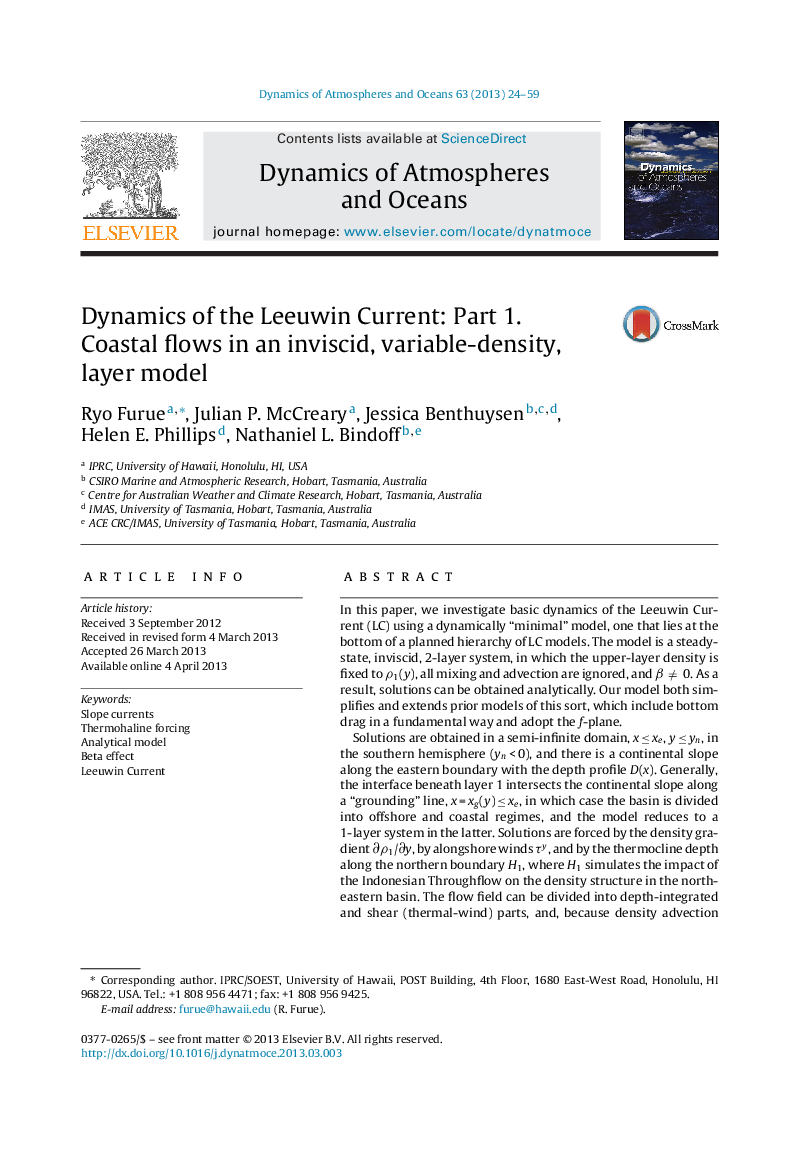| کد مقاله | کد نشریه | سال انتشار | مقاله انگلیسی | نسخه تمام متن |
|---|---|---|---|---|
| 6426542 | 1634227 | 2013 | 36 صفحه PDF | دانلود رایگان |

- An inviscid two-layer model produces a slope current driven by a density gradient.
- A surface onshore flow downwells within the slope current and returns offshore.
- The flow is determined entirely by Rossby-wave propagation from the coast.
- The strength of the flow is sensitive to the upper-layer (thermocline) thickness.
- The flow transport is insensitive to the profile of the slope.
In this paper, we investigate basic dynamics of the Leeuwin Current (LC) using a dynamically “minimal” model, one that lies at the bottom of a planned hierarchy of LC models. The model is a steady-state, inviscid, 2-layer system, in which the upper-layer density is fixed to Ï1(y), all mixing and advection are ignored, and β â  0. As a result, solutions can be obtained analytically. Our model both simplifies and extends prior models of this sort, which include bottom drag in a fundamental way and adopt the f-plane.Solutions are obtained in a semi-infinite domain, x â¤Â xe, y â¤Â yn, in the southern hemisphere (yn < 0), and there is a continental slope along the eastern boundary with the depth profile D(x). Generally, the interface beneath layer 1 intersects the continental slope along a “grounding” line, x = xg(y) â¤Â xe, in which case the basin is divided into offshore and coastal regimes, and the model reduces to a 1-layer system in the latter. Solutions are forced by the density gradient âÏ1/ây, by alongshore winds Ïy, and by the thermocline depth along the northern boundary H1, where H1 simulates the impact of the Indonesian Throughflow on the density structure in the northeastern basin. The flow field can be divided into depth-integrated and shear (thermal-wind) parts, and, because density advection is neglected, the former is independent of the latter. The depth-integrated equations are hyperbolic, their solution determined by the offshore propagation of boundary values along Rossby-wave characteristics.Even though there is no Rossby-wave damping, a coastal jet is trapped over the slope. Both the coastal jet and the offshore flow field are completely determined by the offshore propagation of signals from the coast; moreover, the offshore circulation depends only on the depth of the continental shelf at the coast, D(xe), and is independent of the slope profile farther offshore. For density-driven solutions, the grounding line shifts offshore and hence the LC deepens poleward; there is downwelling over the shelf, as well as westward flow at the bottom of the upper layer, both associated with the thermal-wind circulation and existing only when β â  0; the speed of the coastal jet is proportional to âD/âx; and its transport is proportional to H12, so that it is strongest farther offshore and is very sensitive to the specified thermocline thickness in the northern basin. When equatorward wind stress is included, an equatorward jet can develop very nearshore provided that the wind stress is strong enough to overcome the density forcing.
Journal: Dynamics of Atmospheres and Oceans - Volume 63, September 2013, Pages 24-59